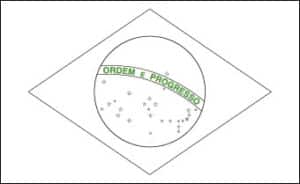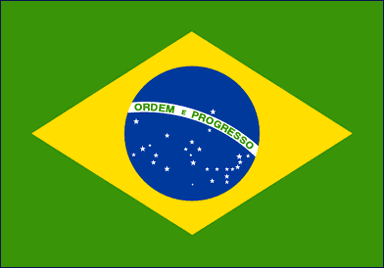
The Brazilian national flag, created by Raimundo Teixeira Mendes, has a huge yellow rhombus in the center of a green background. A blue circle with white stars of various sizes, like a starry sky, is inside the rhombus. The circle is surrounded by a white banner. “Ordem e Progresso“—which translates as “Order and Progress” in English—is written on the circle.
The Brazil Flag has a total of twenty-seven white stars. Every single “Federal District” and state of Brazil is represented by a different star. The golden color of the diamond shape represents Brazil’s gold riches, while the green color represents Brazil’s lush grassland and woodland region. The largest gold mines in the world were formerly located in Brazil.
Facts about Brazil flag |
|---|
| Country | Brazil |
|---|---|
| Designed by | Raimundo Teixeira Mendes |
| Adopted | November 19, 1889 (21-star version) May 11, 1992 (27-star version) |
| Revision | 1989, 1992 |
| Design and Colors | A blue disc depicting a starry sky spanned by a curved band inscribed with the national motto, within a yellow rhombus, on a green field. |
| Size Ratio | 7:10 |
| Official Name: | The Federative Republic of Brazil |
| Proportion: | 7:10 |
| Adopted on: | May 11, 1992 |
| Location: | South America bordered by Venezuela, Guyana, Suriname, French Guyana, Colombia, Bolivia, Peru, Argentina, Paraguay, and Uruguay |
| Capital City: | Brasilia |
| Major Cities: | Sao Paulo, Rio de Janeiro, Santa Cararina, Parana |
| Area: | 3,287,612 square miles |
| Population: | 201,009,622 [according to July 2013 estimate] |
| Currency: | Real (R$) (BRL) |
| Official Language: | Portuguese |
| National Anthem: | Hino Nacional Brasileiro |
| National symbol(s): | Southern Cross constellation |
| National colors: | green, yellow, blue |
| National anthem: | |
| Name: | “Hino Nacional Brasileiro” (Brazilian National Anthem) |
| Lyrics/Music: | Joaquim Osorio Duque ESTRADA/Francisco Manoel DA SILVA |
Historical Background
The current design of the Brazilian flag was officially adopted on November 19, 1889, shortly after Brazil transitioned from an empire to a republic. The flag’s design was inspired by the ideas of the Republican movement and the desire to create a symbol of a new, independent Brazil.
Design and Colors
The Brazilian flag features a green field with a large yellow diamond in the center, inside which is a blue circle with 27 white five-pointed stars arranged in the pattern of the Southern Cross constellation. In the center of the blue circle is a white band with the national motto “Ordem e Progresso” (Order and Progress) inscribed in green letters.
Symbolism of the Brazilian Flag
Each element of the Brazilian flag holds significant symbolism. The green color represents Brazil’s lush forests and its hope for a bright future. The yellow diamond symbolizes Brazil’s wealth and resources. The blue circle with stars represents the Brazilian sky and the country’s 27 states and the Federal District.
The Southern Cross constellation inside the blue circle is an important navigational reference in the Southern Hemisphere. The white band with the motto “Ordem e Progresso” symbolizes Brazil’s commitment to order, progress, and unity.
Brazilian Independence Day
Brazilian Independence Day is celebrated on September 7th each year, commemorating the day in 1822 when Brazil declared independence from Portugal. This day is marked by various celebrations, parades, and flag-raising ceremonies, showcasing the importance of the Brazilian flag as a symbol of independence and national identity.
FAQs
Q1: When was the current design of the Brazilian flag adopted?
The current design of the Brazilian flag was officially adopted on November 19, 1889.
Q2: What do the colors on the Brazilian flag represent?
The green color represents Brazil’s lush forests and hope for the future, while the yellow symbolizes the country’s wealth and resources.
Q3: What do the stars on the Brazilian flag represent?
The 27 stars inside the blue circle represent Brazil’s 26 states and the Federal District.
Q4: What is the significance of the Southern Cross constellation on the Brazilian flag?
The Southern Cross constellation is an important navigational reference in the Southern Hemisphere and represents Brazil’s geographic location in the southern part of the world.
Q5: What is the national motto inscribed on the Brazilian flag?
The national motto inscribed on the Brazilian flag is “Ordem e Progresso,” which means “Order and Progress” in Portuguese. It symbolizes Brazil’s commitment to order, progress, and unity.

